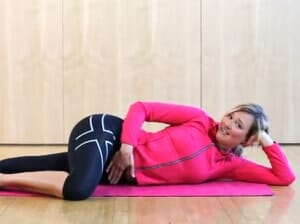Why The Pelvic Floor Is So Important In Post Pregnancy Exercise
The pelvic floor is an area of your exercise and pregnancy weight loss plan that is incredibly important for all women, especially mothers.
 The pelvic floor is an area of your exercise and pregnancy weight loss plan that is incredibly important for all women, especially mothers.
The pelvic floor is an area of your exercise and pregnancy weight loss plan that is incredibly important for all women, especially mothers.
You might familiar with the infamous Kegel exercises from the 80s and 90s? They were super popular and then suddenly disappeared. Maybe it was because people associate the pelvic floors with peeing and “holding it midstream”. However uncomfortable the discussion makes you, your pelvic floor is crucial to regain the functionality of your core.
Understanding how to lift up on your pelvic floor is directly linked to the strengthening of the core muscles and you will hear Pilates instructors talk about it often.
If you’ve read this far and haven’t clicked away yet – well done.
Your pelvic floor – the FACTS
So here is your pelvic floor. An array of muscle and ligaments that extend from your pubic bone all the way backwards to your tailbone. We often do not think about it until something goes wrong or our midwife or Pilates instructor talks about it. The pelvic floor is an involuntary stabilising muscle. We trigger with exercises such as trampolining. After pregnancy, the tissues and muscles may have stretched and weakened and require strengthening again, sometimes very slowly.
After pregnancy, you may have a little postnatal incontinence. This is when you may pee in your pants a little when you laugh, sneeze or cough. The pelvic floor is to blame. It literally is worn out by baring the weight of your babe.
How to strengthen your pelvic floor
Sow how do you strengthen this infamous pelvic? In an ideal world, you start exercise before the birth of your child and even pregnancy. The stronger your pelvic floor the more support you will give your pregnancy and assist you other core muscle to give you strength and posture with less strain. If you’ve already had your baby, the good news is, you can start anytime – provided you have the all-clear from your doctor.
So let’s go! First of all, you need to become aware of what it feels like to lift up (rather than bear down) on your pelvic floor. A really great but simple exercise is the hip hover and the single-leg lift (see both of the below videos – which also work your core and legs).
Important points to bear in mind are to not get a feeling of “pushing down” = bearing down on the pelvic floor rather than lifting, “bracing your core” = activates the more dominant rectus abdominus, “clenching your buttocks” = activating your gluts rather than the pelvic floor.
How to measure yourself for muscle separation
You should also examine yourself to find out what degree of muscle separation you have experienced before undertaking any post-partum-exercise (needs to be under 2cm) or receive clearance from your Doctor.
Step 1 – In a lying position with knees bent, place your right hand behind your head.
Step 2 – With your left hand position your index finger and middle finger together and place them horizontally in the centreline of your stomach between your abdominals.
Step 3 – From this position slowly raise your head slightly off the floor using your right hand (positioned behind your head) for support. Make sure not to simply lift your head with your hand as this is a comman error – you must perform one basic crunch to fully contract your abdominal muscles to get the best assessment of your separation.
Step 4 – Your abdominals will now be slightly contracting allowing you to see exactly how far your abdominals have separated.
Step 5 – If your index finger and middle finger (on your left hand) can still fit between your abdominals you will have Diastasis Recti of between 2 – 2.5cms. For every additional finger you can place inbetween your abdominals you should add 1cm extra to your total abdominal separation number. If you can only fit one finger between your abdominals you effectively have 1cm of separation and will be nearly healed.
If you discover you have more than a 1 – 2cm separation you should refrain from doing exercises such as crunches, sit-ups or pilates 100’s all of which can put too much pressure on the abdominal muscles which have become separated during pregnancy.
Just remember we always advise gaining your Doctor’s clearance before doing any kind of exercise post pregnancy as doing too much too soon can lead to injury and long term problems.
Pelvic Floor & Core Strengthening Exercise – Single Leg Lift
Pelvic Floor & Core Strengthening Exercise -The Hip Hover
The best part about strengthening your pelvic floor (besides not peeing accidently), you may more likely orgasm during sex (but remember what lead to babies in the first place!!!)
Stay tuned for next weeks post and video on the stomach and core – the complex routine that needs to be followed to regain your tummy plus specific exercises and the journey to getting your tummy back.
To see Sol’s past articles and videos click here
This article was written by Sol Walkling, the Lose Baby Weight Pilates Expert and Trainer – to see Sol’s credentials and read more about her click here









